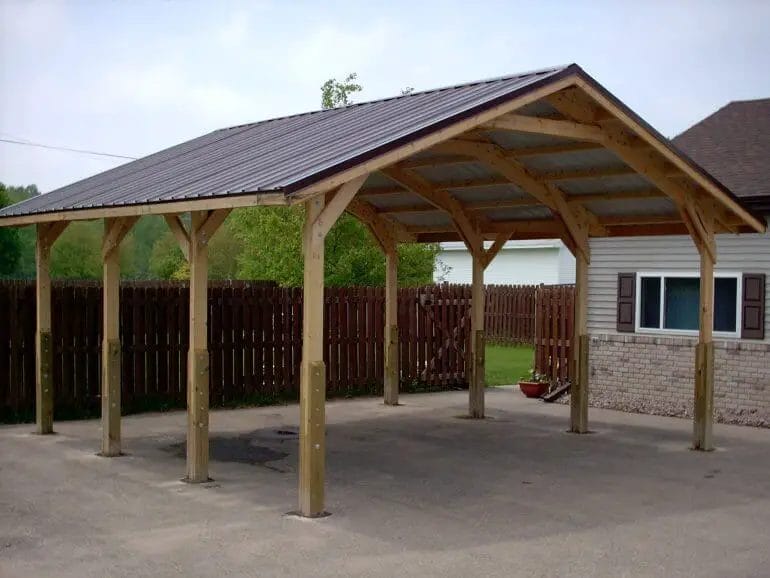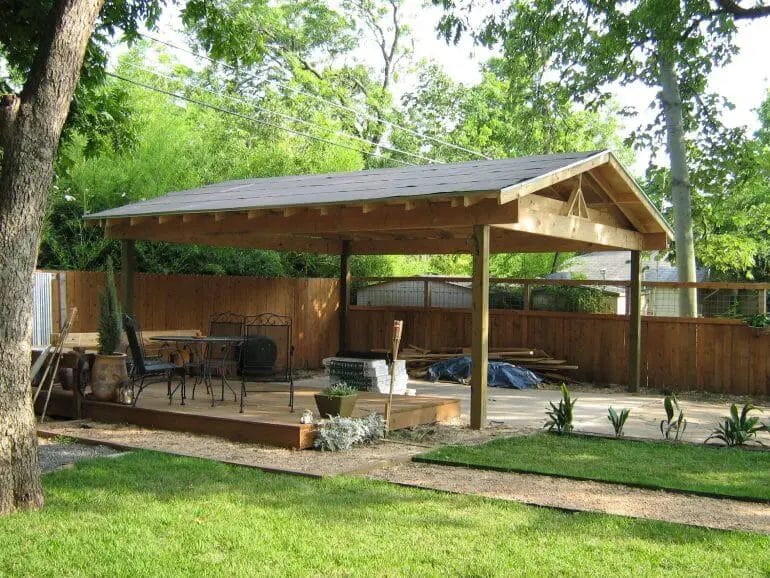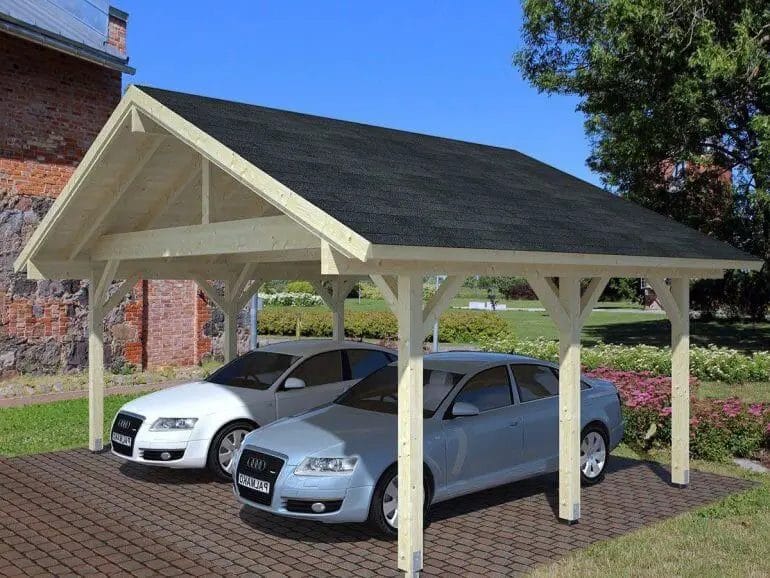Looking for a cost-effective and durable carport solution? Building a carport out of wood can be the perfect option to protect your vehicles from the elements, while adding a stylish touch to your property. With the right materials and a bit of DIY skills, you can create a sturdy and aesthetically pleasing structure that will provide shelter for your vehicles for years to come. In this guide, we will walk you through step-by-step instructions on how to build a wood carport, ensuring a practical and attractive addition to your home.

Choosing the Right Wood for Your Carport
A carport is a valuable addition to any home, providing protection for your vehicles from the elements and adding value to your property. When it comes to building a carport, choosing the right wood is important to ensure its durability and longevity. This article will guide you through the process of selecting the best wood for your carport, taking into consideration factors such as strength, resistance to weather conditions, and overall aesthetics.

1. Pressure-Treated Wood
Pressure-treated wood is an excellent choice for carports due to its durability and resistance to decay and insect infestation. This type of wood is treated with chemicals that protect it from moisture, rot, and termites. Pressure-treated wood is available in various sizes and can be easily found at most home improvement stores.
When using pressure-treated wood for your carport, it is important to choose wood that is rated for ground contact. This ensures that the wood is adequately protected against moisture and soil-borne pests. Additionally, be sure to follow the manufacturer’s instructions for installation and maintenance to maximize the lifespan of your carport.
2. Cedar
Cedar is a popular choice for carports due to its natural beauty and resistance to decay. It is known for its aromatic fragrance and rich color variations, which can add an attractive aesthetic to your carport. Cedar wood also contains natural oils that act as a deterrent against insects and rot.
Although cedar is naturally resistant to decay, it is recommended to apply a protective finish or stain to further enhance its durability. Regular maintenance, such as cleaning and reapplying the protective finish, will help extend the lifespan of your cedar carport.
3. Redwood
Redwood is another type of wood that is highly resistant to rot, decay, and insect infestation. It has a natural reddish-brown color that can add warmth and beauty to your carport. Redwood is also known for its stability and durability, making it a reliable choice for long-term use.
Similar to cedar, redwood can be left untreated as it naturally repels insects and decay. However, for added protection and aesthetics, applying a sealant or stain is recommended. Regular maintenance, such as cleaning and resealing, will help preserve the color and integrity of your redwood carport.
4. Douglas Fir
Douglas fir is a strong and versatile wood that is commonly used for structural purposes, including carports. It has a light reddish-brown color and a straight grain pattern, providing an attractive and uniform appearance. Douglas fir is known for its dimensional stability, making it less prone to warping and shrinking.
While Douglas fir is not naturally resistant to decay, it can be treated with preservatives to increase its durability. Regular maintenance, such as sealing and staining, will help protect the wood and prolong the life of your carport.
Summary
When selecting the right wood for your carport, it is essential to consider factors such as durability, resistance to weather conditions, and overall aesthetics. Pressure-treated wood, cedar, redwood, and Douglas fir are all excellent choices that offer different benefits and visual appeal.
Remember to choose wood that is suitable for ground contact and follow the manufacturer’s instructions for installation and maintenance. Regular cleaning, sealing, and staining will help protect the wood and ensure the longevity of your carport. With the right wood choice and proper maintenance, your carport will provide reliable protection for your vehicles for years to come.

Essential Tools for Building a Wooden Carport
Building a wooden carport can be a rewarding DIY project that not only provides shelter for your vehicles but also adds value to your property. However, before you embark on this venture, it’s important to gather the essential tools that will help you successfully complete the project. Here are some key tools you’ll need:
1. Measuring Tape
A measuring tape is an indispensable tool for any construction project. It allows you to accurately measure the dimensions of the carport, ensuring that the structure is properly sized and aligned. Make sure to choose a sturdy tape measure that can withstand outdoor conditions.
2. Circular Saw
A circular saw is a versatile cutting tool that will come in handy when working with wood. It allows you to make precise and straight cuts, ensuring that each piece fits together seamlessly. Look for a circular saw with adjustable cutting depth and a durable blade.
3. Power Drill
A power drill is essential for drilling holes and driving screws into the wooden components of the carport. Opt for a drill that offers multiple speed settings and comes with a variety of drill bits and screwdriver bits. This will ensure that you have the necessary tools for different tasks.
4. Level
A level is crucial for ensuring that your carport is built on a level surface. It helps you keep the structure plumb and prevents any tilting or unevenness. Invest in a high-quality bubble level that is easy to read and provides accurate measurements.
5. Hammer
A hammer is a basic tool that you’ll need for various tasks, such as driving nails and securing wooden components. Look for a hammer with a comfortable grip and a sturdy head to ensure efficient and precise work.
6. Chisels
Chisels are useful for shaping and trimming wood, especially when fitting joints or making precise cuts. Invest in a set of chisels with different sizes to accommodate various woodworking needs. Make sure to keep them sharp for optimal performance.
7. Clamps
Clamps are essential for holding pieces of wood together while you work on assembling the carport. They provide stability and ensure that the components are securely fastened. Consider getting a mix of quick-release clamps and bar clamps for versatility.
8. Safety Gear
Lastly, don’t forget about safety gear. When working with power tools and handling wood, it’s important to protect yourself. Wear safety glasses to shield your eyes from debris, gloves to protect your hands, and ear protection to reduce noise exposure.
In Summary
Building a wooden carport requires a set of essential tools that will facilitate the construction process and ensure a successful outcome. Measuring tape, circular saw, power drill, level, hammer, chisels, clamps, and safety gear are all vital for this project. By investing in quality tools and taking proper safety precautions, you can embark on your carport building journey with confidence.

Step-by-Step Guide to Constructing a Wooden Carport
Constructing a wooden carport is a great way to provide protection and coverage for your vehicles. Whether you need additional parking space or simply want to safeguard your car from the elements, a wooden carport can be a practical and aesthetic addition to your property. In this step-by-step guide, we will walk you through the process of building a wooden carport from start to finish.
Materials and Tools Needed
Before you begin the construction process, gather all the necessary materials and tools. Here is a list of items you will need:
- Pressure-treated lumber
- Concrete mix
- Post hole digger
- Circular saw
- Hammer
- Drill
- Lag bolts
- Wood screws
- Level
- Tape measure
- Paint or stain (optional)
Step 1: Planning and Preparation
Start by determining the size and location of your carport. Measure the area and mark the boundaries using stakes and string. Check with your local building codes to ensure compliance and obtain any necessary permits.
Step 2: Digging Post Holes
Use a post hole digger to dig holes for the support posts of your carport. The depth and spacing of the holes will depend on the size and design of your carport. Typically, holes should be at least 2 feet deep and spaced evenly apart.
Step 3: Installing the Support Posts
Place the support posts into the holes and fill them with concrete mix. Use a level to ensure the posts are plumb and allow the concrete to dry according to the manufacturer’s instructions.
Step 4: Building the Frame
Using pressure-treated lumber, construct the frame of the carport. Cut the lumber to the desired lengths and attach them together using lag bolts or wood screws. Make sure the frame is square and level.
Step 5: Adding the Roof
Attach the roof panels to the frame using screws or nails. Ensure that the panels are securely fastened and provide adequate coverage for your vehicles. Consider adding a slope to the roof to allow for proper drainage.
Step 6: Finishing Touches
If desired, you can paint or stain the wooden carport to enhance its appearance and protect it from weathering. Be sure to choose a paint or stain that is suitable for outdoor use.
Summary
Building a wooden carport can be a rewarding and cost-effective project. By following this step-by-step guide, you can construct a sturdy and functional carport that will provide shelter for your vehicles for years to come. Remember to prioritize safety and consult professional help if needed. Happy building!
Tips for Maintaining and Protecting Your Wooden Carport
A wooden carport is a valuable investment that not only provides protection for your vehicles but also enhances the overall appearance of your property. To ensure that your wooden carport lasts for years to come and maintains its aesthetic appeal, it is important to follow a regular maintenance and protection routine. In this section, we will discuss some essential tips to help you maintain and protect your wooden carport.
1. Regular Cleaning
Regular cleaning is crucial to prevent dirt, debris, and other unwanted buildup on your wooden carport. Use a mild detergent diluted in water to gently scrub the surface of the carport. Rinse thoroughly with clean water and allow it to air dry. Avoid using harsh chemicals or abrasive cleaners, as they can damage the wood.
2. Inspect and Repair Damages
Regularly inspect your wooden carport for any signs of damage, such as cracks, rot, or loose screws. Address any repairs promptly to prevent further deterioration. Replace any damaged or rotted wood, and tighten loose screws or bolts. Consider applying wood filler or sealant to fill in cracks and protect the wood.
3. Apply Protective Finish
To protect your wooden carport from weather elements and UV rays, apply a protective finish. Choose a finish that is specifically designed for outdoor use and is suitable for wood. Apply the finish according to the manufacturer’s instructions and make sure to cover all surfaces, including the underside of the carport.
4. Maintain Proper Drainage
Ensure that your wooden carport has proper drainage to prevent water buildup. Remove any leaves or debris that may clog the gutters or downspouts. Regularly check the drainage system and make necessary repairs or modifications to ensure water flows away from the carport.
5. Regular Inspection for Pests
Wooden structures are susceptible to pests such as termites, ants, and wood-boring insects. Regularly inspect your wooden carport for any signs of infestation, such as sawdust, holes, or insect activity. If you notice any signs, contact a professional pest control service to address the issue promptly.
6. Avoid Heavy Loads
Avoid placing heavy objects or excessive weight on your wooden carport. This can put unnecessary strain on the structure and potentially cause damage. Be mindful of the weight capacity of your carport and avoid overloading it.
7. Regularly Trim Surrounding Vegetation
Trim any nearby trees, branches, or shrubs that may come into contact with your wooden carport. Overhanging branches can scrape against the wood, causing scratches or damage. Additionally, keeping vegetation away from the carport can prevent moisture buildup and minimize the risk of pests.
8. Provide Adequate Ventilation
Ensure that your wooden carport has proper ventilation to prevent moisture buildup and potential rot. Trim any vegetation blocking air circulation and consider installing vents or louvers to promote airflow. Adequate ventilation will help prolong the lifespan of your carport.
9. Protect from Extreme Weather
In regions with extreme weather conditions, take additional measures to protect your wooden carport. Consider installing storm shutters or panels to shield the carport from strong winds and flying debris. If heavy snowfall is expected, regularly remove snow from the carport roof to prevent excessive weight and potential collapse.
10. Professional Inspection and Maintenance
Regularly schedule professional inspections and maintenance for your wooden carport. A professional can identify any underlying issues, provide necessary repairs or treatments, and offer expert advice on maintaining the condition of your carport.
In summary, regular cleaning, inspecting for damages, applying protective finishes, maintaining proper drainage, inspecting for pests, avoiding heavy loads, trimming surrounding vegetation, providing adequate ventilation, protecting from extreme weather, and scheduling professional inspections are essential for maintaining and protecting your wooden carport. By following these tips, you can ensure the longevity and functionality of your wooden carport while preserving its aesthetic appeal.
FAQs
1. How do I build a carport out of wood?
To build a carport out of wood, start by creating a solid foundation using posts or concrete footings. Next, construct the framework using treated lumber and secure it with galvanized screws. Install the roof trusses, plywood sheathing, and roofing material. Lastly, finish by adding any desired features like siding or gutters.
2. What materials do I need to build a wood carport?
To build a wood carport, you’ll need materials like treated lumber for the framework, galvanized screws for securing the structure, roofing material (such as shingles or metal panels), plywood for sheathing, and any additional features like siding or gutters.
3. Do I need a building permit to construct a wood carport?
Building permit requirements vary depending on your location, so it’s essential to check with your local building department. In many cases, a permit is required for constructing a carport, even if it’s made of wood. Failure to obtain the necessary permits may result in fines or other penalties.
Conclusion
In conclusion, building a carport out of wood is a cost-effective and versatile solution for protecting your vehicles from the elements. With the right materials and a good plan, you can create a sturdy and durable carport that will enhance the functionality and aesthetics of your property.
Wooden carports offer the advantage of easy customization, allowing you to match the design and style of your existing architecture. Additionally, wood is a renewable and eco-friendly material, making it a great choice for environmentally-conscious individuals.
Remember to carefully consider the local building codes and regulations before starting your project. By following proper construction techniques and maintenance, your wooden carport will provide years of reliable service and protection for your vehicles.